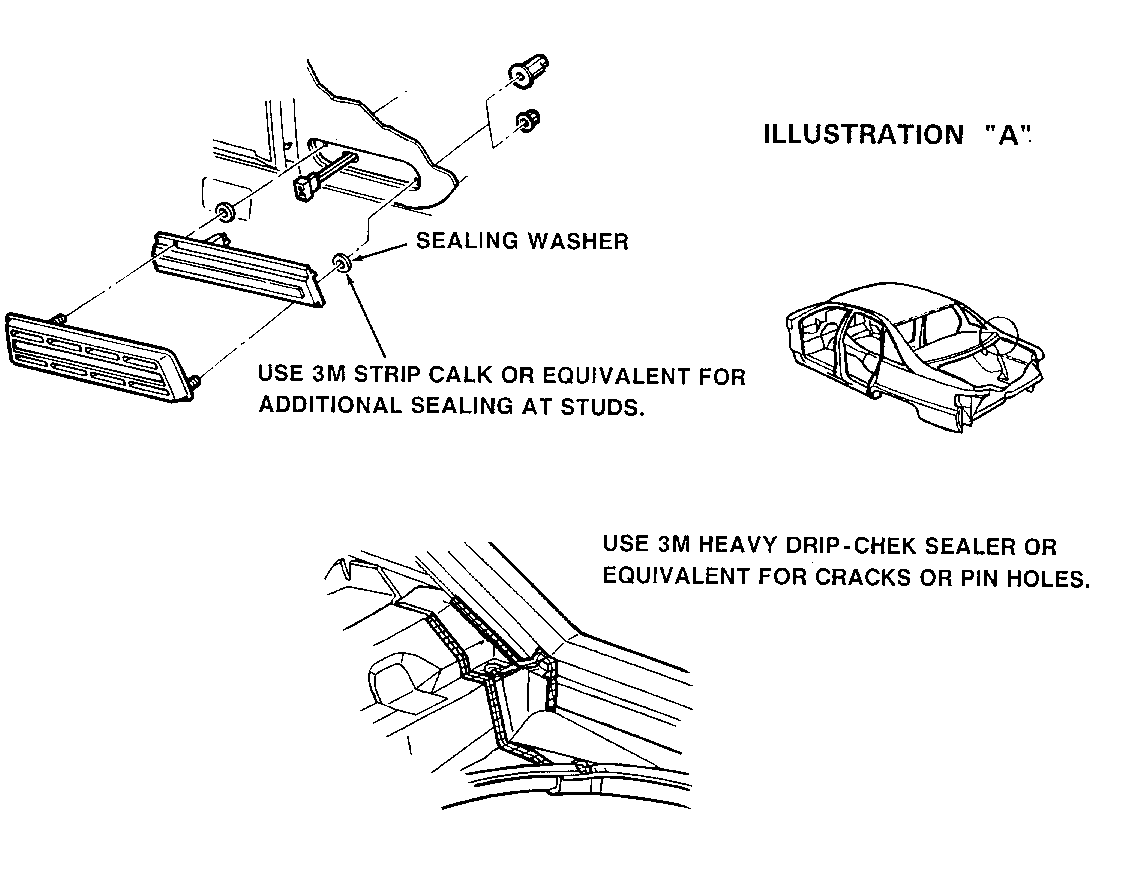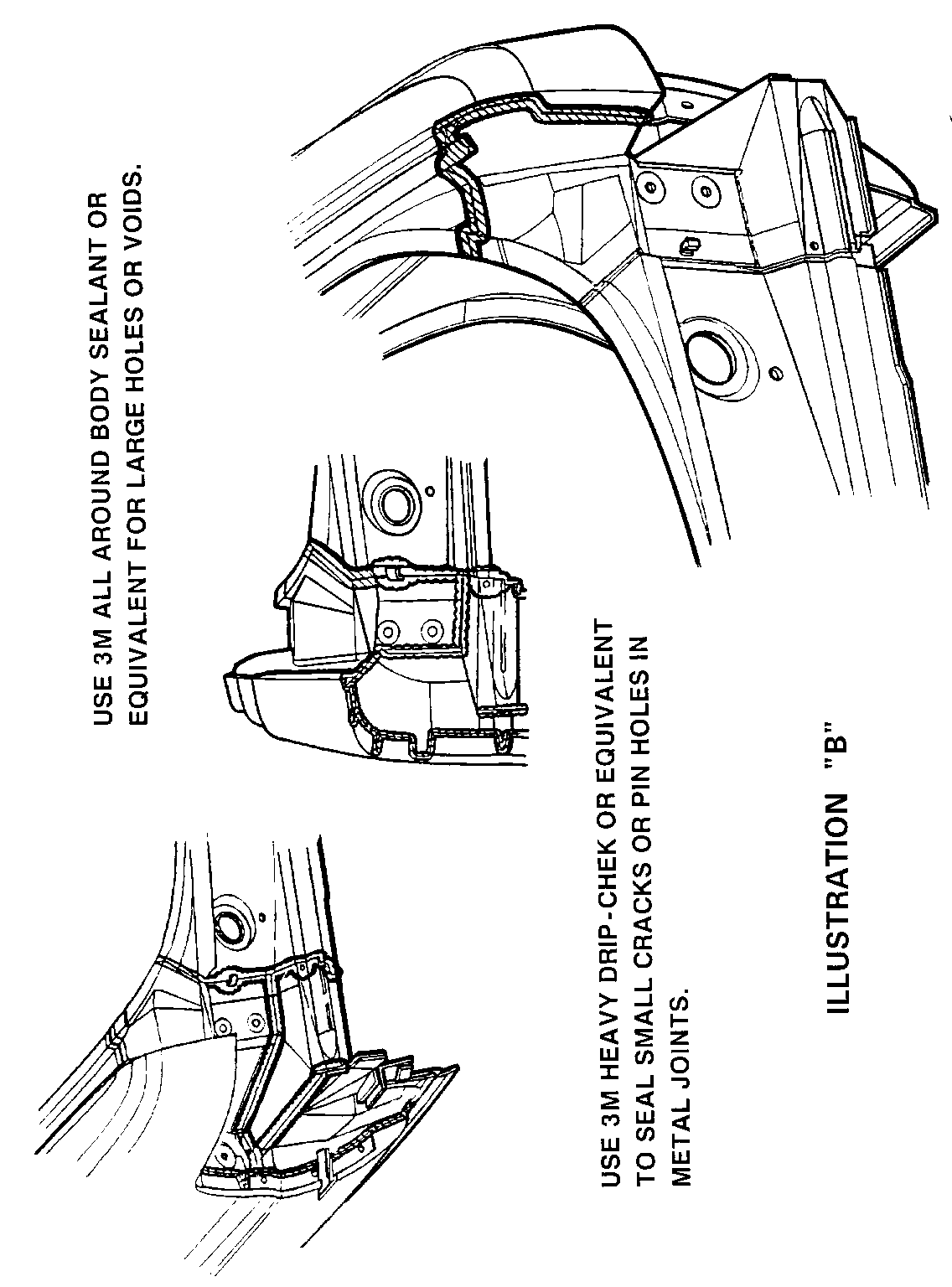REAR COMPARTMENT WATER LEAK CORRECTIONS

SUBJECT: REAR COMPARTMENT WATER LEAK CORRECTIONS
MODELS AFFECTED: 1992 ROADMASTER SEDANS
Buick vehicles are designed to operate under normal environmental conditions. The design criteria for sealing materials and components takes into consideration the sealing forces required to withstand the natural elements. These specifications do not, and cannot, take into consideration all artificial conditions such as may be encountered in some high pressure car washes.
The water test method has been correlated to the natural elements and will determine the ability of a vehicle to perform under normal operating conditions.
Repairing body water leaks is basically a problem of proper testing, diagnosis and repair through adjustments of misaligned components and/or application of proven repair materials. The first step in water leak diagnosis is determining the conditions under which the leak occurs. For example, a leak noticed only when parked on an inclined drive or muddy water in trunk after a long drive in the rain.
If the general leak area can be accurately identified, the exact entry point can be quickly isolated by use of a localized test, such as, a water hose or air hose. If, the leak source is not obvious, the generalized testing method using water test stands should be used. (See Service Manual Section 10-1.) This test is advised because it applies a large volume of water to a general area without exceeding the sealing limitations of the rear compartment or tailgate opening weatherstrips. Also, use of test stands or similar water test equipment is advised for retest to confirm repair and see if additional leaks may be contributing to the original condition.
If the water testing of a broad area is required for leak detection or for the purpose of confirming a repair, the test stands or similar water test equipment should be arranged to provide enough coverage. Specifications for water test stand construction are shown in the 1992 Roadmaster Service Manual, Section 10-1.
If the specified water pressure of 155 KPA (22 PSI) cannot be obtained because of a local situation, both stands may be moved toward the vehicle until water spray overlap can be achieved.
Localized Spot Testing:
When making localized test with either water or air hose, begin test at the base of the joint, seam or section and proceed slowly upward until the leak is found. It is very important to pinpoint the leak area before any repair is attempted because random repair may only temporarily restrict water entry and make future diagnosing and repair more difficult.
Rear Compartment Leaks:
Metal panel joint leaks at the back window opening and back window sealant leaks in the lower corner are often confused. To properly diagnose a sealant leak, remove reveal molding and pour bubble solution (liquid detergent) on suspect area while applying a low pressure air (30 PSI) to the same area from inside the car. To determine if metal joint is contributing to leak, apply air pressure from inside the rear compartment.
Seal small cracks or pin holes in metal joints with 3M* Drip-Chek Sealer #8531 or equivalent. Large holes or voids can be sealed with 3M All-Around Autobody Sealant #8500, or equivalent.
If panel joint leak is beneath the rear compartment front panel, remove the panel as described in the Service Manual, if the vehicle has a vinyl cover it will be necessary to remove the cap as described in the Roadmaster Service Manual, Section 10-9.
Cracks or voids in sealer at panel joints can be tested using the air hose and bubble solution. Access to some areas are limited, therefore, it may be necessary to remove some interior trim and/or attach a length of copper tubing to the end of the air hose.
Tail lamps and similar applied components can be tested by applying water from an unrestricted hose around the periphery of the component.
Use 3M* Strip-Calk #8578 or equivalent to seal gaskets or applied component to the body. Seal around bolts, studs and screws.
Wheelhouse leaks may result in muddy water in the rear compartment. In order to simulate the force of water thrown up into this area by the rear tires, a nozzle or heavy thumb pressure on the end of a water hose is required. It may be necessary to remove the rear wheel to thoroughly test this area.
Panel configuration may prevent detection from inside the rear compartment, therefore, an air gun with an extension may be more helpful. Apply air to the seams from inside the rear compartment and detect from outside of the wheelhouse area.
To repair, pack 3M* Strip-Calk #8578 or equivalent into cracks and open seams from outside the body and cover repair area with 3M* Body Schutz #8864 or equivalent.
The attached illustrations, "A and B", show areas to be checked for water leaks and materials which MAY be used for repair of leaks.
Upon completion of any water leak repair, the general leak area should be retested. Do not use air hose or water hose to test a repaired area as the material may be dislodged under abnormal pressure.
WARRANTY INFORMATION:
Labor Operation No.: B5410 Labor Time: 0.4 Hr.
* "We believe this source and their equipment to be reliable. There may be additional manufacturers of such equipment. General Motors does not endorse, indicate any preference for or assume any responsibility for the product or equipment from these firms or for any such items which may be available from other sources."


General Motors bulletins are intended for use by professional technicians, not a "do-it-yourselfer". They are written to inform those technicians of conditions that may occur on some vehicles, or to provide information that could assist in the proper service of a vehicle. Properly trained technicians have the equipment, tools, safety instructions and know-how to do a job properly and safely. If a condition is described, do not assume that the bulletin applies to your vehicle, or that your vehicle will have that condition. See a General Motors dealer servicing your brand of General Motors vehicle for information on whether your vehicle may benefit from the information.
